Toys on a shoestring . . . sometimes literally!
2 Oct 2010
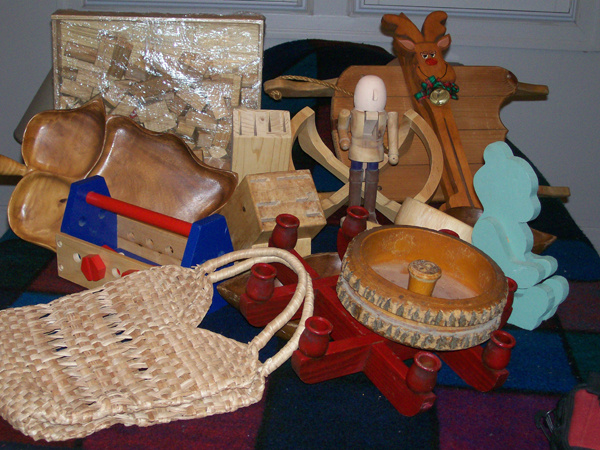
Fat and Magical Bird Toys in a Lean Economy
by Madeleine Franco
Probably the most money I ever spent on a toy for one of my parrots was approximately 10 years ago. It was the most fabulous “gorilla” toy one could imagine. It easily weighed 15 pounds and was multi-colored wood blocks and beads everywhere. The cost was $58.00, and it lasted approximately the same number of minutes, most of which time Tommy, my Eleanora cockatoo, spent chewing its rather large cardboard tag into little bits. Crunch, crunch, crunch; snap, snap, snap; crash! It was over in short order for that toy. The big bonus was that somewhere in all that crunching and snapping, Tommy must have gotten thirsty and stopped to take a drink. I further conclude that he dripped some water on his erstwhile snow white feathers and leaned into one of the bright green pieces of wood. Despite many baths, Tommy spent the better part of the ensuing several months wearing a hint of pastel green on his chest, a constant reminder of the frivolity of my spending.
We’ve all been there. But, that was then and this is now. In an economy that is lackluster at best, few have $58 to plunk down for less than an hour of self-indulgence, even if it’s our own. So, adjust we must. But, birds gotta play, and it is up to us to provide them with interesting, challenging and now perhaps “cheap” toys.
With a flock the size of mine, even a $1,000 toy budget wouldn’t go very far, so improvisation is the name of the game. Lucky for us, our birds don’t care what we paid for a windowsill or even for a couch, let alone what we pay for their toys. And, if the major purpose of a toy is to destroy it (“a toy destroyed is a toy enjoyed”), then the color or style is not terribly important to them either. This leaves open an entire world of improvisation possibilities and a myriad of materials that meet the destructible criteria.
Ah, but our birds do seem to demand interesting, and they are often interested in everyday things that we ourselves use or discard. Many years ago—when I didn’t have nearly as many of them—my birds were all housed in my home office. I began to notice that when I’d crumple up a piece of paper, I would get nearly everyone’s attention. So, I crumpled up a clean sheet of paper and gave it to my rose-breasted cockatoo, who seemed the most interested of all. That piece of paper kept Floyd busy for nearly an hour, and a ball of paper is still one of his favorites, albeit one of his messiest toys for all the confetti he is able to make of it. He also likes rolled magazines and just about anything made of cardboard, though I avoid putting large boxes in his cage so as not to stimulate hormonal behavior.
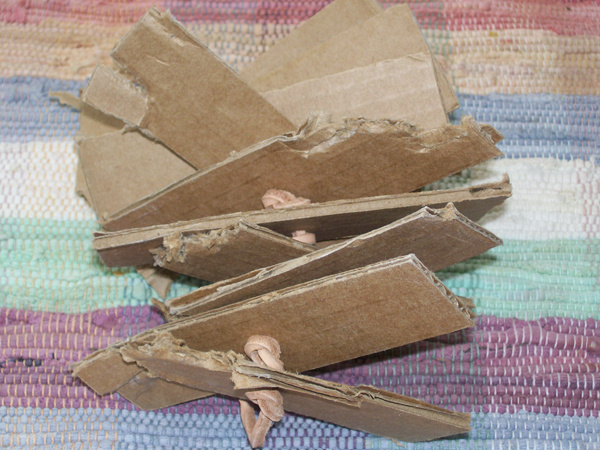 Among the various types of cardboard available, corrugated cardboard—and the thicker the better—is an all-time hit; and the simplest, though highly entertaining, of toys can be made by stringing cardboard pieces (approximately 3” x 5”) on a strand of bird-safe cord (cotton or sisal) or vegetable-tanned leather. Tie a knot at the bottom and between each piece of cardboard, and hang the toy in the middle of the cage. The knots prolong the life of the toy by acting as stops, so that if your bird removes one piece of the cardboard, all the others won’t fall to the floor. Additionally, a knotted length of cord is less likely to form a loop that could prove hazardous. Even among birds like SC2 Tommy and palm cockatoos, who will destroy a wood toy within minutes, corrugated cardboard is good for hours of fun, as it cannot be snapped but must be “worked.” Among the various types of cardboard available, corrugated cardboard—and the thicker the better—is an all-time hit; and the simplest, though highly entertaining, of toys can be made by stringing cardboard pieces (approximately 3” x 5”) on a strand of bird-safe cord (cotton or sisal) or vegetable-tanned leather. Tie a knot at the bottom and between each piece of cardboard, and hang the toy in the middle of the cage. The knots prolong the life of the toy by acting as stops, so that if your bird removes one piece of the cardboard, all the others won’t fall to the floor. Additionally, a knotted length of cord is less likely to form a loop that could prove hazardous. Even among birds like SC2 Tommy and palm cockatoos, who will destroy a wood toy within minutes, corrugated cardboard is good for hours of fun, as it cannot be snapped but must be “worked.”
Foraging is all the rage among bird owners these days, but foraging has always been the rage among birds. Numerous everyday items can be turned into foraging toys, including small milk and half and half containers, larger milk containers cut in half and reassembled, and clear water bottles. The latter have the additional advantage of revealing a glimpse of the prizes inside, and if the cap is a sport-cap, that provides a bonus foot toy that my female Moluccan can’t resist. Any of these containers can be filled with edible treats wrapped in paper, foot toys and other miscellany that parrots just can’t resist. Additionally, the plastic caps of fruit juice, water bottles and laundry detergent bottles may be used as foot toys as is, or may be drilled and strung with leather and beads or strung several on a strand of leather and made into a hanging toy. I run all caps through the dishwasher before using them in toy-making projects.
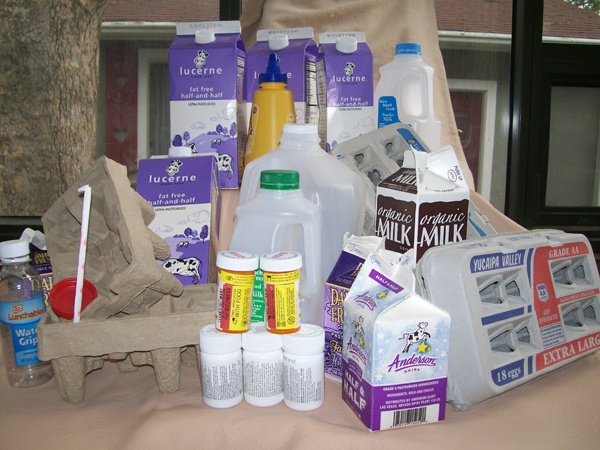
While your own everyday items represent a bounty toward improvised toy-making, if you’re going to take your improvisation seriously to provide an endless variety of toys for your birds, then you must become familiar with “dollar stores” and thrift stores. Both provide virtually unlimited treasure, much of which can be used “as is,” following a cycle through the dishwasher, or with the simple addition of an eye screw and quick link for hanging in a cage. I continue to be absolutely amazed at the preponderance of monkey pod wood that ends up in thrift stores. Monkey pod is a hard, tight-grained tropical wood most often used to make those wonderful 70s salad sets, nut bowls and whatever other whatnots no one any longer seems to use or never used in the first place. The thrift stores I frequent are full of monkey pod items of all sizes and descriptions. Because this wood was intended to contain food and snacks, the oil used to finish it is food-safe, and hence bird-safe. Attributable to its hardness and its tight and irregular grain, monkey pod cannot be destroyed in long splinters like pine and some of the other woods often used for bird toys. While monkey pod can be sliced, drilled and strung into toys, such slicing and drilling should be done only with the proper equipment and with the full knowledge that a chop saw or drill press can easily turn such hard wood into a dangerous projectile if not handled correctly. That said, items made of monkey pod are unsurpassed for keeping even my Major Mitchell’s cockatoos destructively entertained.
Dante, my male MM2, can’t seem to decide whether he prefers monkey pod or the knife blocks I also buy for him from the thrift stores. Knife blocks are another “as is” item that are a major hit among my wood-loving cockatoos, and all those slots and openings are perfect for stuffing with edible treasure like nuts and sunflower seeds. Every time I go to a thrift store I can’t help but wonder if anyone actually uses knife blocks anymore for the purpose intended and why they might, as the fun derived from them by my birds seems to indicate a knife block’s highest and best use. Some have said that I shouldn’t educate my competition like this. I warn you, however; if we both happen to be in the same thrift store at the same time, and it’s between you and me who gets the knife block, I win! 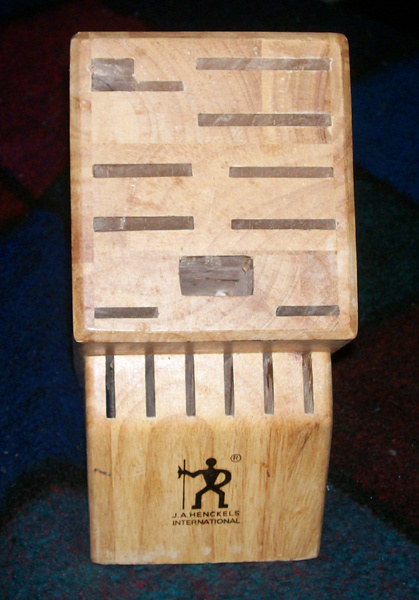
In addition to monkey pod items and knife blocks, thrift stores yield a variety of bird safe baby toys, rattles, baskets, unfinished wood craft projects and the like that my birds find highly entertaining. Mostly what you need to add is just a little imagination to turn these items into hours of fun. Experiment to discover your birds’ preferences, and you’ll become a specialist shopper. A friend of mine buys all the straw purses and hats she can find—many of which are overstock items—and makes them into foraging toys. Another purchases baby denim overalls, removes all the metal findings, sews various large buttons all over them, fills the pockets with nuts, and hangs them in her birds’ cages. The large buttons are another thrift-store find. Yet another friend found that her cockatoos went nuts for Barbie dolls, which are in no short supply in thrift stores these days, and she regularly make clean sweeps through all the thrift stores in town. I find that to be a bit raw and on the edge, and some have even told her that’s just wrong, but she claims it keeps her from going broke trying to keep her cockatoos entertained. I have never asked her how she discovered her birds were enamored of Barbies, but somehow I always imagine a rather puzzled bird on time out and a little girl sobbing uncontrollably. Incidentally, I’ve been told by another friend that Barbies are okay, but My Little Pony is strictly off limits. I’m guessing that the definition of sacred is somewhat generational, and my own birds will never even know about my collection of Madame Alexander dolls, notwithstanding they’ve all been in a box somewhere for dozens of years.
In addition to my prowling the thrift stores, my visits to various “dollar stores” are the source of numerous items that easily can be made into toys. I always check the baby and toy aisles, and the children’s games and toys. I almost always purchase a couple of decks of cards, which can’t be beat for making toys for some of my smaller birds, who seem to like especially the miniature playing cards. Using the same principle as with the corrugated cardboard toy, I use a paper punch to make holes in the cards, and I string the cards, alternating with wooden or plastic beads or even snips of drinking straws, onto several strands of leather, or clean shoelaces, again using knots as stops. Otherwise useless keys, of which I never have fewer than several dozen on hand for some reason, serve as bottom weights. I knot the strands together at one end, fit with a quick link, and voila . . . another hanging toy for next to nothing.
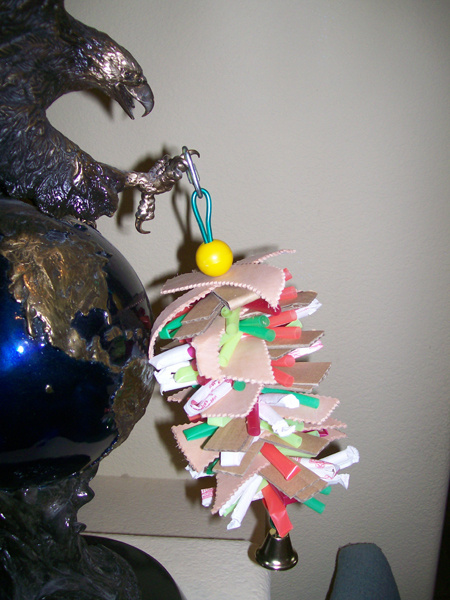 Combining corrugated cardboard, drinking straws, beads, leather, and strips of fabric, one can make an absolutely nifty toy I call the “Straw Boss.” Begin by placing a weight—either a bell or a key—at one end, knotting the weight in place. Follow with a large pony bead. Then string a single piece of cardboard, a small piece of vegetable tanned leather scrap, and several clean drinking straws (cut or folded in half with a hole punched in the middle), followed by a strip of fabric, knotting the leather strand after the fabric strip. I usually use five folded straws. Repeat that process five or six times. Put a final bead at the top, making a final knot with a small loop for hanging. Thick, bird-safe wire may be substituted for the leather strand, using small loops or bends as stops. The biggest expense in this toy are the drinking straws; the leather scraps, available from any leather craft store usually for a pittance; and a leather punch, which can be used in subsequent projects. The magic of the Straw Boss is that it is full of different textures, which provide great therapy for pluckers. Combining corrugated cardboard, drinking straws, beads, leather, and strips of fabric, one can make an absolutely nifty toy I call the “Straw Boss.” Begin by placing a weight—either a bell or a key—at one end, knotting the weight in place. Follow with a large pony bead. Then string a single piece of cardboard, a small piece of vegetable tanned leather scrap, and several clean drinking straws (cut or folded in half with a hole punched in the middle), followed by a strip of fabric, knotting the leather strand after the fabric strip. I usually use five folded straws. Repeat that process five or six times. Put a final bead at the top, making a final knot with a small loop for hanging. Thick, bird-safe wire may be substituted for the leather strand, using small loops or bends as stops. The biggest expense in this toy are the drinking straws; the leather scraps, available from any leather craft store usually for a pittance; and a leather punch, which can be used in subsequent projects. The magic of the Straw Boss is that it is full of different textures, which provide great therapy for pluckers.
In making bird toys, don’t overlook Nature’s bounty. Clean, bird-safe branches, with leaves intact, are always a favorite. Canaries, finches and small parrots such as caiques, can spend hours running through wet, leafy branches or mint bouquets placed in their cages. If you live in a tropical or sub-tropical region, fresh palm fronds and eucalyptus hung or woven through cage bars are always favorites to provide hours of threading and shredding fun; wet adds a new dimension. Pine cones of various sizes and textures, either stuffed with treats or served a la carte, make wonderful foraging and preening toys. Be sure the pine cones are clean, pest-free and pesticide free. Several pine cones, crumpled paper, a scrap of vegetable-tanned leather or two and some nuts stuffed into a metal treat cage or “Iron Maiden,” can provide hours of fun. And, if a branch heavily laden with fruit breaks off one of your fruit trees, consider that an opportunity to provide an edible toy for your birds.
Now, it is said that when the going gets tough, the tough get going. So, if the economy’s got you down, get tough and get going--to the yard, to the attic, and to the thrift and dollar stores in search of great treasure and faded glory that can shine once again as a great bird toy. You don’t need a lot of dollars, just mostly your imagination, and that’s free. I don’t know about you, but whenever I make something for my birds out of nothing, it always puts a smile on my face. 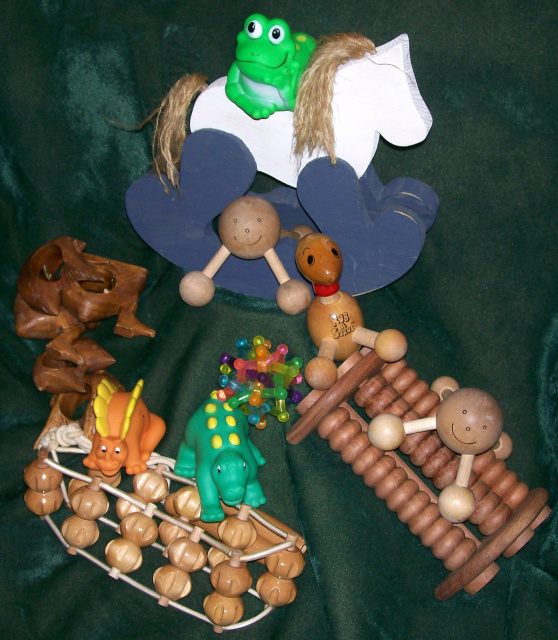
Copyright © 2010 Madeleine Franco, all rights reserved. Madeleine Franco is an award-winning business writer/presenter and founding president of the Southern Nevada Parrot Education, Rescue & Rehoming Society (SNPERRS). She is an avicultural hobbyist who tends a flock of approximately 30 non-breeding, highly platonic and interactive pet parrots. Madeleine is also the owner/operator of Premium Pine Cones, LTD. (www.nattynewfeathers.com), specializing in remedies, toys and diversions for parrots that pluck but would like to kick the habit. This article was originally published in the AFA Watchbird: Journal of the American Federation of Aviculture, Volume XXXVII, No. 2, Summer-2010. Those wanting to reprint this article must also obtain the permission of the AFA; contact birdwire@earthlink.net.
Madeleine Franco
|